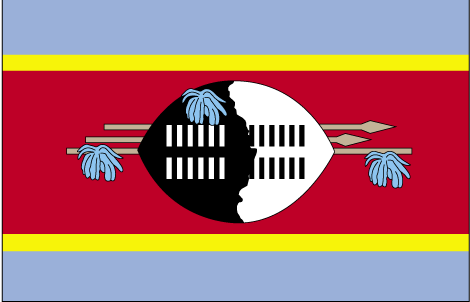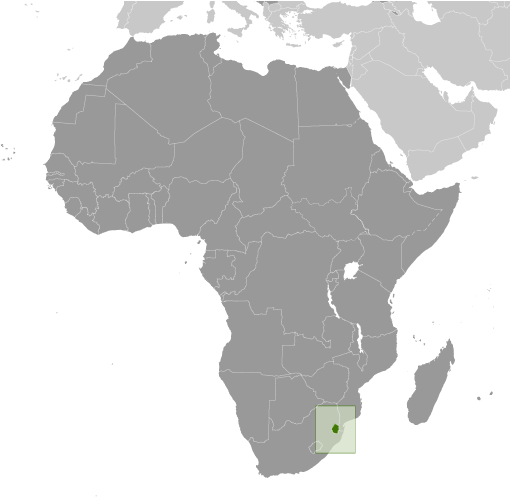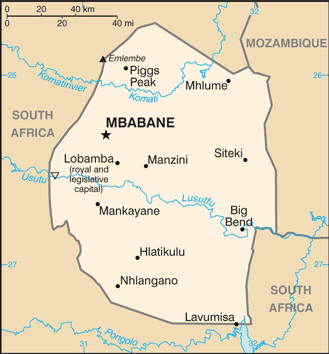|
Economy - overview:
|

|
|
Surrounded by South Africa, except for a short border with Mozambique, Swaziland depends heavily on South Africa from which it receives more than 90% of its imports and to which it sends 60% of its exports. Swaziland's currency is pegged to the South African rand, effectively subsuming Swaziland's monetary policy to South Africa. The government is heavily dependent on customs duties from the Southern African Customs Union (SACU), and worker remittances from South Africa supplement domestically earned income. Subsistence agriculture employs approximately 70% of the population. The manufacturing sector has diversified since the mid-1980s. Sugar and wood pulp were major foreign exchange earners; however, the wood pulp producer closed in January 2010, and sugar is now the main export earner. Mining has declined in importance in recent years with only coal and quarry stone mines remaining active. Customs revenues plummeted due to the global economic crisis and a drop in South African imports. The resulting decline in revenue has pushed the country into a fiscal crisis. Swaziland is looking to other countries, including South Africa, for assistance, but continues to struggle to meet its monthly payroll and fund government programs. With an estimated 40% unemployment rate, Swaziland's need to increase the number and size of small and medium enterprises and attract foreign direct investment is acute. Overgrazing, soil depletion, drought, and floods persist as problems for the future. More than one-fourth of the population needed emergency food aid in 2006-07 because of drought, and more than one-quarter of the adult population has been infected by HIV/AIDS.
|
|
|
GDP (purchasing power parity):
|

|
|
$6.148 billion (2012 est.)
country comparison to the world: 164
$6.332 billion (2011 est.)
$6.317 billion (2010 est.)
note:
data are in 2012 US dollars
|
|
|
GDP (official exchange rate):
|

|
|
$3.651 billion (2012 est.)
|
|
|
GDP - real growth rate:
|

|
|
-2.9% (2012 est.)
country comparison to the world: 212
0.3% (2011 est.)
2% (2010 est.)
|
|
|
GDP - per capita (PPP):
|

|
|
$5,300 (2012 est.)
country comparison to the world: 152
$5,400 (2011 est.)
$5,400 (2010 est.)
note:
data are in 2012 US dollars
|
|
|
GDP - composition by sector:
|

|
|
agriculture: 8.2%
industry:
47%
services:
44.8% (2012 est.)
|
|
|
Labor force:
|

|
|
457,900 (2007)
country comparison to the world: 157
|
|
|
Labor force - by occupation:
|

|
|
agriculture: 70%
industry:
NA%
services:
NA%
|
|
|
Unemployment rate:
|

|
|
40% (2006 est.)
country comparison to the world: 188
|
|
|
Population below poverty line:
|

|
|
69% (2006)
|
|
|
Household income or consumption by percentage share:
|

|
|
lowest 10%: 1.7%
highest 10%:
40.1% (2010 est.)
|
|
|
Distribution of family income - Gini index:
|

|
|
50.4 (2001)
country comparison to the world: 20
|
|
|
Investment (gross fixed):
|

|
|
14.2% of GDP (2012 est.)
country comparison to the world: 139
|
|
|
Budget:
|

|
|
revenues: $1.447 billion
expenditures:
$1.459 billion (2012 est.)
|
|
|
Taxes and other revenues:
|

|
|
39.6% of GDP (2012 est.)
country comparison to the world: 50
|
|
|
Budget surplus (+) or deficit (-):
|

|
|
-0.3% of GDP (2012 est.)
country comparison to the world: 49
|
|
|
Inflation rate (consumer prices):
|

|
|
8.4% (2012 est.)
country comparison to the world: 186
6.1% (2011 est.)
|
|
|
Central bank discount rate:
|

|
|
6.5% (31 December 2010 est.)
country comparison to the world: 47
6.5% (31 December 2009 est.)
|
|
|
Commercial bank prime lending rate:
|

|
|
9% (31 December 2012 est.)
country comparison to the world: 101
9% (31 December 2011 est.)
|
|
|
Stock of narrow money:
|

|
|
$335.8 million (31 December 2012 est.)
country comparison to the world: 168
$355.1 million (31 December 2011 est.)
|
|
|
Stock of broad money:
|

|
|
$1.106 billion (31 December 2012 est.)
country comparison to the world: 168
$1.087 billion (31 December 2011 est.)
|
|
|
Stock of domestic credit:
|

|
|
$960 million (31 December 2012 est.)
country comparison to the world: 159
$948.6 million (31 December 2011 est.)
|
|
|
Market value of publicly traded shares:
|

|
|
$203.1 million (31 December 2007)
country comparison to the world: 113
$199.9 million (31 December 2006)
|
|
|
Agriculture - products:
|

|
|
sugarcane, cotton, corn, tobacco, rice, citrus, pineapples, sorghum, peanuts; cattle, goats, sheep
|
|
|
Industries:
|

|
|
coal, wood pulp, sugar, soft drink concentrates, textiles and apparel
|
|
|
Industrial production growth rate:
|

|
|
1% (2010 est.)
country comparison to the world: 133
|
|
|
Current account balance:
|

|
|
-$3.8 million (2012 est.)
country comparison to the world: 58
-$280.9 million (2011 est.)
|
|
|
Exports:
|

|
|
$1.985 billion (2012 est.)
country comparison to the world: 143
$2.04 billion (2011 est.)
|
|
|
Exports - commodities:
|

|
|
soft drink concentrates, sugar, wood pulp, cotton yarn, refrigerators, citrus and canned fruit
|
|
|
Imports:
|

|
|
$2.111 billion (2012 est.)
country comparison to the world: 163
$2.108 billion (2011 est.)
|
|
|
Imports - commodities:
|

|
|
motor vehicles, machinery, transport equipment, foodstuffs, petroleum products, chemicals
|
|
|
Reserves of foreign exchange and gold:
|

|
|
$752.3 million (31 December 2012 est.)
country comparison to the world: 145
$600.5 million (31 December 2011 est.)
|
|
|
Debt - external:
|

|
|
$737.3 million (31 December 2012 est.)
country comparison to the world: 165
$703.2 million (31 December 2011 est.)
|
|
|
Stock of direct foreign investment - at home:
|

|
|
$NA
|
|
|
Stock of direct foreign investment - abroad:
|

|
|
$NA
|
|
|
Exchange rates:
|

|
|
emalangeni per US dollar -
8.223 (2012 est.)
7.2597 (2011 est.)
7.3212 (2010 est.)
8.42 (2009)
7.75 (2008)
|
|
|
Fiscal year:
|

|
|
1 April - 31 March
|
|
|
|





 )
)



